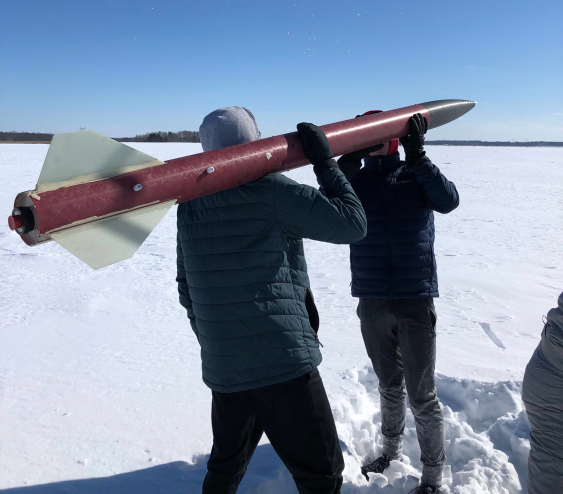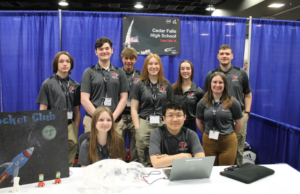S.T.A.R.S Rocket Club win top award at NASA student launch

Above, members of the S.T.A.R.S Rocket Club traveled to North Branch, Minn., this winter to do a test launch. The team just won the most prestigious award at the 2019 NASA studet launch.
On April 6 in Huntsville, Ala., after eight months of hard work, the Science, Technology And Rocketry Students Rocket Club (S.T.A.R.S.) watched their 8-foot, 25-pound rocket ascend into the sky at the NASA student launch. “It is really hard to launch a high powered rocket, so with what we did, it was a success,” S.T.A.R.S team captain and senior Erik Walther said.
“There was some pressure coming back from winning the award last year if we would completely flop, but we hoped for something successful, and it paid off. It is hard with teams from all over the country to tell what they are going to bring to the table with their different projects year to year,” rocket club mentor Zeb Nicholson said.
The main goal of this launch was to emphasize safety. It led to a successful launch.
“We wanted a safe decent. That was our first priority that NASA had given us. Everything came down undamaged, though payload wasn’t fully successful. The payload section is one small aspect of the launch, so if that wasn’t successful in the 400 feet that the rocket descended, I don’t see it as unsuccessful,” payload design team member and senior Calvin Timmer said.
For this year’s rocket, the S.T.A.R.S’ project was to have a “parawing” that deploys from the rocket and can manually land at a predesignated GPS point. As a result of all of their hard work, the rocket club received $2,000 from the Judges Choice award for the second year in a row.
“It is the best high school award, which we got last year as well. It is decided by a secret panel of judges throughout the week by showing good teamwork and dedication to S.T.E.M.,” Walther said.
The team worked months to write proposals, design, construct and test-launch the rocket in order to fly at the NASA launch this month. The team experienced struggles in the test launch stage of the rocket with temperatures of -20 and 18 inches of snow at the closest certified launch site in North Branch, Minn.
“Every person’s phone died from the cold. We didn’t even have the chance to videotape it because of how cold it was. It was so cold people were almost getting frostbite. The quarter mile walk to the launch pad was through knee-deep snow,” outreach team leader, safety team member and senior Marika Yang said.
The team also had concerns due to safety with their design while proposing it to the NASA board. The team worked over 300 man hours to fix this problem during numerous school issued snow days.
“During our presentation phases after our Critical Design Review, they were talking about how they were not confident in our design concerning safety. They let us do something called a Delta Review. There was whole week window where we did not have school because of snow days, and the team grinded for the payload,” Timmer said. “I didn’t know if we were going to get to Alabama at that point.”
Although the students experienced some technical difficulties with the rocket’s payload, they proved their spot in the competition.
“The students learned a really great lesson and pulled through with it. It was tough. There were NASA engineers asking them hard questions about the project. We almost lost our spot and had to stop the project because people at NASA were not quite confident with what we had. The students came back full force and let NASA know that we knew what we were going to do, and we ended up getting the top award,” Nicholson said.
From budget cuts to the 2019 NASA student launch, only seven schools out of the large amount that applied were chosen, fewer schools than previous years. This also limited the amount of public schools attending the competition, giving private S.T.E.M.-based schools an upper hand.
“This year was definitely more competition because we were one of two public schools out of the seven. Some schools were special private S.T.E.M schools, and as one of the only public high schools, we did the best,” Walther said.
Next year, the S.T.A.R.S. will have to start over the process to be invited into the NASA launch, but still have a good shot at making it back into the experience in Alabama because of their two years of first place winning rockets.
“We were only given a two-year invitation to launch with NASA. We have to figure a new project for next year. There is a really good chance that we will go back to TARC (Team America Rocket Challenge.) If we do well enough at that, we can hopefully go back to the NASA launch,” Nicholson said. “To not only be chosen for this opportunity, but to be number one in the end is a huge deal for the team,” he said.









You must be logged in to post a comment Login